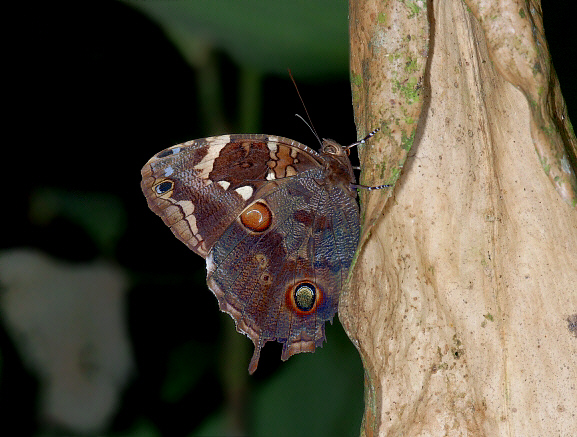 Opoptera aorsa hilaris, Rio Madre de Dios, Peru – Adrian Hoskins
Opoptera aorsa hilaris, Rio Madre de Dios, Peru – Adrian Hoskins
Introduction
The Morphinae comprises of about 140-150 neotropical species, of which 93 are included within the tribe Brassolini. Of these 73 are placed in the Brassolina – a subtribe including the genera Brassolis, Blepolenis, Caligo, Caligopsis, Catoblepia, Dasyophthalma, Dynastor, Mielkella, Eryphanis, Penetes, Mimoblepia, Opoptera, Opsiphanes, Orobrassolis and Selenophanes. All Brassolines are crepuscular or nocturnal in behaviour, although a few species also fly by day in the darkest areas of the forest.
The genus Opoptera comprises of 6 known species – aorsa, arsippe, fruhstorferi, sulcius, syme and a newly discovered Peruvian species that has not yet been named.
Opoptera aorsa is distributed from Colombia to southern Peru.
Habitats
This species is found in primary and secondary rainforest, and in cloudforest at altitudes up to at least 1800 metres. It is often associated with stands of bamboo or banana.
Lifecycle
The eggs are white and globular, finely ribbed, and laid in clusters of between 2-5 on leaves of the foodplant Chusquea ( bamboo ). The larva is pale green, with a series of thin brown and yellowish lines along the back, and a pair of brown caudal tails. The head is pale brown and has a pair of long black horns, and a short pale horn on each cheek. The chrysalis is long and cylindrical, tan coloured with numerous fine dark striations, and has the general appearance of a piece of bamboo stem.
Adult behaviour
During daytime Opoptera rest on decaying stems or thin branches at a height of about 1m but they are normally only seen at dawn when they visit rotting fruit or herbivore dung on the forest floor.
In Brazil by torchlight I have seen groups of up to 6 adults flying in close contact with each other in the corner of a small glade after dark, at about 1900hrs. This probably indicates that courtship and copulation occur in the early part of the evening. In the Peruvian Andes I found an adult imbibing moisture from mud in the middle of a road at midday, in cloudy weather, at an altitude of 1800m.
